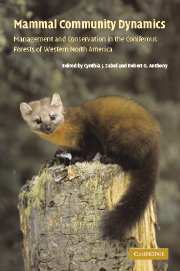 Mammal Community Dynamics
Mammal Community Dynamics Published online by Cambridge University Press: 15 December 2009
Three groups of mammals that occur in coniferous forests of western North America are closely associated with large healthy, decaying, or dead trees: bats, arboreal rodents, and forest carnivores. Detailed descriptions of the ecological relations of these species are presented elsewhere in this book (Buskirk and Zielinski 2003, Hayes 2003, Smith et al. 2003). Although many other kinds of mammals use large vertical forest structures to some degree, these are the species groups that depend on them to meet their life history requirements. Consequently, these are also the mammals that are most likely to suffer population declines in forests where these structures are reduced in abundance. The need to provide for large snags and decadent trees in managed forests to maintain populations of cavity-using birds and mammals has received much attention in the literature (e.g., Balda 1975, Thomas 1979, Hoover and Wills 1984, Brown 1985). However, the perceived consequences of providing inadequate numbers and sizes of these structures in managed forests have generally been limited to the decline or loss of the wildlife species that depend on them. The broader ecological consequences that could also result from the loss or decline of tree-dwelling birds and mammals have received relatively little attention (but see Machmer and Steeger 1995, Aubry and Raley 2002).
Managing forests primarily for timber production often involves not only the removal of a substantial proportion of large, healthy trees from each harvest unit, but also the elimination of large dead or decadent trees.
To save this book to your Kindle, first ensure [email protected] is added to your Approved Personal Document E-mail List under your Personal Document Settings on the Manage Your Content and Devices page of your Amazon account. Then enter the ‘name’ part of your Kindle email address below. Find out more about saving to your Kindle.
Note you can select to save to either the @free.kindle.com or @kindle.com variations. ‘@free.kindle.com’ emails are free but can only be saved to your device when it is connected to wi-fi. ‘@kindle.com’ emails can be delivered even when you are not connected to wi-fi, but note that service fees apply.
Find out more about the Kindle Personal Document Service.
To save content items to your account, please confirm that you agree to abide by our usage policies. If this is the first time you use this feature, you will be asked to authorise Cambridge Core to connect with your account. Find out more about saving content to Dropbox.
To save content items to your account, please confirm that you agree to abide by our usage policies. If this is the first time you use this feature, you will be asked to authorise Cambridge Core to connect with your account. Find out more about saving content to Google Drive.